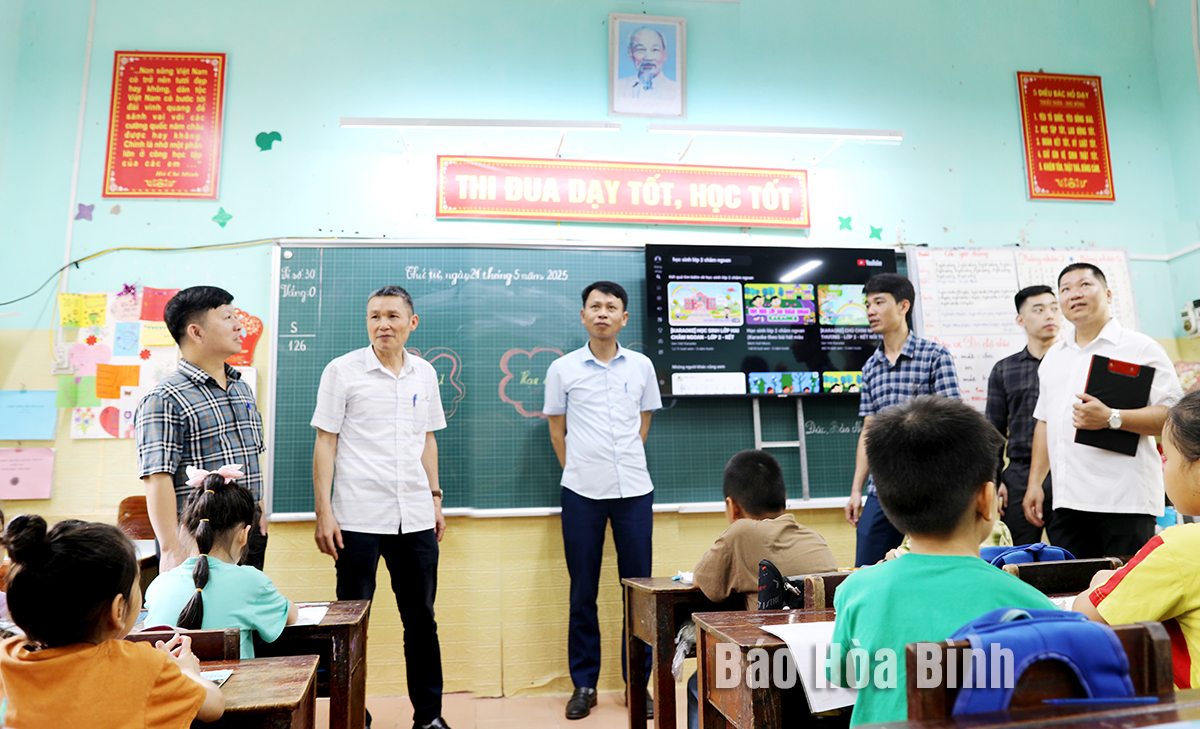



The representatives from the CIIDC, the Department of Economy - Infrastructure and Urban Development of Lac Son District, and the People’s Committee of Vu Ban town visit the school lighting model at Vu Ban Primary and Secondary School.
As part of Hoa Binh Province’s Energy Efficiency Program for 2025, the CIIDC recently accepted and handed over a school lighting system at Vu Ban Primary and Secondary School in Vu Ban town (Lac Son District), a school with a large student population, cramped classrooms, and outdated, inconsistent lighting. After conducting a site survey, the CIIDC supported the installation of new lighting systems in 6 classrooms. Each room was equipped with 6 sets of 36W classroom LED lights and 2 sets of 18W board lights, using high-quality products from Rang Dong Light Source & Vacuum Flask JSC.
Post-installation measurements showed that all technical parameters met the lighting standards. The modern LED lights are energy-efficient, providing soft lighting, and they are glare-free, ensuring eye safety for students. With a total cost of 74 million VND, the model has significantly improved lighting and the learning environment.
A representative from the CIIDC emphasized that the center focuses not only on the technical aspects but also on the actual usability, carefully surveying each classroom, selecting the appropriate equipment, and optimizing both cost and energy efficiency.
Mr. Pham Van Chien, the Vice Chairman of Vu Ban Town’s People’s Committee, shares his hopes: "It is our wish to continue receiving meaningful and practical projects like this from higher authorities. The local government will actively monitor the effective implementation of the model, facilitate the project execution, and ensure its quality and efficiency. The model helps save electricity, reduce greenhouse gas emissions, and improve educational quality. We hope it will be expanded throughout the area.”
Since 2021, the CIIDC has implemented its first models at Dong Chum Primary School in Da Bac District and the schools in remote areas such as Quy Hoa and Mien Doi Communes in Lac Son District. Despite the initial challenges, these models have shown clear results: they have improved lighting, students’ focus, and more effective teaching. They have also raised awareness among schools, parents, and students about energy efficiency.
According to Mr. Duong Quoc Thang, the Deputy Director of the Department of Industry and Trade, the plan for using energy efficiently and economically in Hòa Bình Province for the 2021 - 2025 period.
in the period of 2021 - 2025, approved by the Provincial People’s Committee under Decision No. 1616/QĐ-UBND dated July 17, 2020, laid the groundwork for practical and effective model implementation. Since 2021, five school lighting models with a total investment of 450 million VND have been implemented along with a widespread public awareness campaign.”
More than short-term benefits, the school lighting model lays a foundation for a generation of students to study in environments with standard, scientifically designed lighting, a seemingly simple factor that has profound effects on learning capacity, vision, and long-term health. Through the model, the concepts like "energy saving”, "electricity efficiency” and "greenhouse gas emissions” are no longer abstract terms, but integrated into classroom lessons, remembered and practiced by students, and shared throughout the community.
Looking back on the journey since 2021, it’s clear that the school lighting model spearheaded by the CIIDC is not merely about installing lighting equipment. It is a deep-rooted initiative tied to the goals of sustainable development. From a small model with the practical implementation, its large-scale impact is now spreading a powerful message, illuminating knowledge and nurturing hope for students on their journey toward learning and growth.